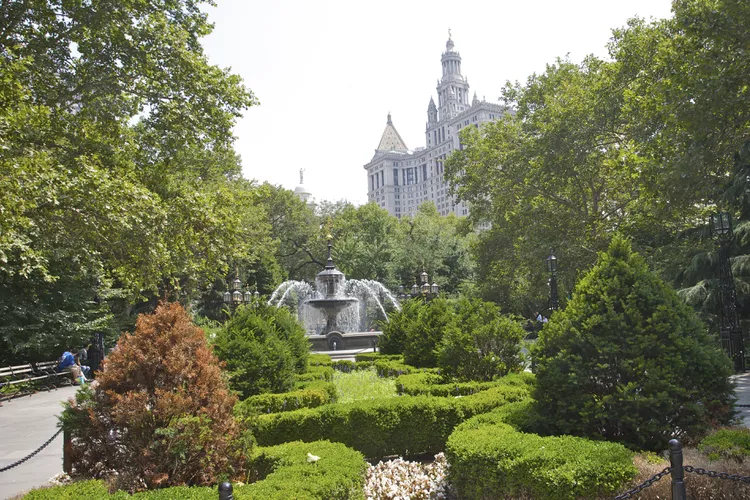Summary
Explore City Hall Park in Manhattan
Overview of City Hall Park
This triangular plot of historic park space, nestled within Manhattan’s bustling Civic Center (between Broadway, Park Row, and Chambers Street), offers a perfect retreat from the downtown hustle, whether you’re visiting the area for work or leisure.
Spanning 8.8 acres of lush lawns and attractive landscaping, City Hall Park presents an ideal vantage point to unwind, perhaps after a visit to the nearby Brooklyn Bridge or after shopping at the renowned Century 21 department store. It also serves as a peaceful spot to reflect following a trip to the profound 9/11 Memorial or Museum.
What to Do at City Hall Park
The park is an excellent location for people-watching; during lunchtime, it becomes bustling with local workers—many of whom are government employees or jury members—who gather to enjoy their breaks. You may even catch sight of Mayor de Blasio himself, taking a few moments away from City Hall, which is situated within the park’s boundaries. Additionally, wedding parties frequently stroll through following ceremonies at the nearby City Clerk’s Office, capturing picturesque shots in the park’s scenic surroundings. Furthermore, you’ll see a continuous flow of cyclists and pedestrians crossing the iconic Brooklyn Bridge.
Prominent buildings line the park’s periphery, including the remarkable Woolworth Building and the Manhattan Municipal Building.
Historical Significance of City Hall Park
As one of the city’s most historically significant green spaces, history enthusiasts will find multiple historical markers scattered around the park, including a unique circular tablet illustrating key events in the park’s past. City Hall Park’s grounds have had various transformations, with its western boundaries following what was once an old Native American trail (now identified as Broadway). It gained recognition as “the Commons” in the late 17th century when it served as a communal pasture for livestock.
These grounds once hosted 18th-century almshouses for the needy, and at the park’s northern end, where the Tweed Courthouse now stands, British soldiers’ barracks and a debtors’ prison existed during the American Revolution—where many prisoners of war perished due to starvation or execution. Most notably, the park functioned as military parade grounds where George Washington read the Declaration of Independence aloud to his troops on July 9, 1776, in preparation for fighting the British.
In 1818, it became home to the city’s first art museum, located in the now-demolished Rotunda building (which was removed in 1870).
City Hall Park and its adjoining City Hall have a rich history of gatherings, rallies, and public events that continue today. A particularly important historic moment on these grounds happened when President Lincoln laid in state at City Hall following his assassination in 1865.
Interesting Landmarks
City Hall Park’s centerpiece is the stunning granite fountain, constructed in 1871, located at its southern edge. Look for bronze gas-lit candelabras at each corner and an umbrella-shaped fixture enveloping its central circular basin. This fountain replaced the original Croton Fountain, which supplied fresh water from the Croton Aqueduct—an impressive engineering achievement at the time, unveiled in 1842. Designed by Jacob Wrey Mould (who co-designed Central Park’s Bethesda Fountain), this fountain was relocated to Crotona Park in the Bronx in 1920 before being restored and returned to City Hall Park in 1999 as part of a significant park restoration project.
The park’s original gas streetlights were replaced with electric lamps in 1903, yet some charming vintage-style light poles remain, including “Fifth Avenue” poles along the sidewalks, and ornate cage poles that line the central paths.
Throughout the park, you can discover more than a dozen markers and monuments (some areas are secured due to City Hall’s proximity). Look for the impressive 13-foot-tall bronze statue of colonial patriot Nathan Hale, an American Revolution-era spy, best known for his poignant last words, “I only regret that I have but one life to lose for my country.” He was executed for treason by the British at the age of 21 in 1776.
Among the intriguing historical markers is one located in front of City Hall, indicating where the initial excavation for NYC’s first subway took place in 1900 (though currently inaccessible due to security blockades). First opened in 1904, the now-closed (since 1945) City Hall subway station lies beneath us, marking the southern terminal of the city’s first subway line. This station was designed to be a showpiece, featuring skylights, brass chandeliers, intricate Guastavino tiles, and beautiful glass tilework. Although it’s primarily used as a turning point for the 6 train now, it remains largely hidden from view—yet members of the New York Transit Museum can participate in occasional guided tours to witness this splendid underground artifact firsthand.





